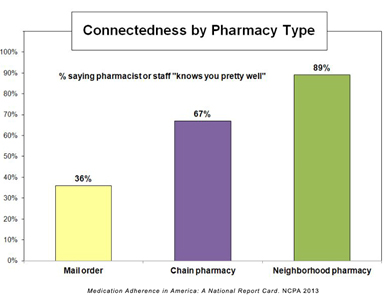A multi-part series on challenges and solutions to better medication adherence
Fear is a powerful emotion. It can cause us to make poor choices in life…either to do something we shouldn’t, or not to do something we should. Fear of side effects is one of the many factors that can impact whether or not a patient will fill and properly take a prescribed medicine.
The potential consequences of this inaction or inaction? Poor medication adherence typically leads to disease progression, the likelihood of increasing ill health (morbidity) and even death (mortality), decreased effectiveness of certain medications over time, increased healthcare costs, and avoidable hospitalizations and waste.
Those are serious negative outcomes to be sure. This fear of potential side effects is just one of the things our clinical pharmacists hear nearly every day as we perform clinical consults. To help guide us and our partner providers as we serve our patients, the RxLive team has performed an extensive review of patients’ comments and peer-reviewed literature to group factors influencing medication adherence into six major “buckets” of the causative factors of medication nonadherence we work to address:
- Side effects
- Cost
- Skills
- Understanding and knowledge (health literacy)
- Social and behavioral factors (both external and internal)
- Access to care and burden of the regimen
Drilling down within those six buckets, separately and taken together, has enabled our clinical team to better evaluate a patient’s situation. They guide our pharmacists in helping patients — as well as their referring providers in many cases — better understand what factors are at play. Through motivational interviewing and empathic listening, in our medication consults we keep all of these intertwined potential issues in mind. This enables us to help patients better comprehend what may be standing in their way of better health and a more-satisfying life.
‘Rational nonadherence’ isn’t always rational
Side effects — secondary undesirable effects that can occur during medication therapy — can lead to rational nonadherence, where lack of adherence occurs due to a fear of adverse effects that are less likely and typically have less impact than not taking the medications at all, or as prescribed. If they consider the side effects likely to be intolerable or unmanageable…well, Houston, we have a problem. It’s an issue that pharmacists have a responsibility to address so patients can make a rational decision, taking all factors into account…including concerns about side effects.
Side effects and other adverse events can manifest in response to an inappropriate dose, incorrect administration, bodily reaction, destruction of other healthy cells, or interactions with other medications or substances. Patients who experience adverse effects sometimes stop the medications, self-adjust their regimen to counter the side effects, or not start their regimen at all.
The National Community Pharmacists Association (NCPA) published in Medication Adherence in America that of >1000 survey respondents, 3 in 10 persons with chronic illnesses experienced unpleasant medication side effects, and 21% reported their medication nonadherence was attributed to concerns about side effects.
Why the fear of side effects hurts adherence
Pharmacists should be vigilant in assessing and identifying patients in populations that are at greater risk for medication nonadherence due to side-effect concerns. Certain populations are at higher risk for adverse drug reactions due to their ability to metabolize drugs or through issues of absorption, elimination or response. This includes a number of groups…older adults, those on related therapies or with multiple disease states, women who are pregnant or breast-feeding, infants and young children, or those with certain hereditary factors. Patients in these populations have an increased likelihood of having themselves experienced unpleasant side effects or have heard “horror” stories from other persons who have done so. (Yes, sometimes those stories grow in the retelling, but regardless, they have an impact on nonadherence.) In these cases, the patient often either doesn’t fill a new prescription, take it as prescribed, and/or doesn’t continue to refill and take the medication due to fear(s).
How pharmacists can dispel fears of taking medication

Trust — According to the 2013 Medication Adherence in America survey by the National Community Pharmacists Association (NCPA), patient trust or “connectedness” with their pharmacist or the pharmacy staff was the strongest individual predictor of medication adherence, with 63% of Americans aged 40+ with chronic conditions reporting a positive sense of their connectedness with their trusted pharmacist or pharmacy.
Pharmacists are key healthcare professionals who can identify and address side-effect concerns during an initial counseling session and, in a retail setting, when medications are first dispensed. Information builds confidence, reduces anxiety and empowers the patient to make informed decisions relating to their health.
The clinical pharmacists on our team work to establish that trust, which is why patients who return for periodic consults meet with their prior RxLive pharmacist…to further build upon and deepen a positive past relationship. We strongly believe in using motivational interviewing and empathic listening in our consults to discover what issues may cause (or be causing) medication nonadherence.
Determining the root cause of fears — Without being unduly pushy in an always-sensitive area, we try to determine the root of a patient’s anxiety about side effects, and work to address their concerns. In a pharmacy consult, we can provide more details about the medication than their physician or other clinician may have had time to provide in an all-too-brief office visit. While we focus on the drug’s positive aspects, we also describe what side effects could occur, so a patient is fully aware of what likely to expect. We also encourage patients to record any occurrences to share on their follow-up consultation with the pharmacist or their physician, and we share any concerns they share with us back with their referring physician to help ensure coordination of care.
Preventing the nocebo effect — Once we’ve broadened the patient’s understanding about a medication, we also work to provide calming techniques that help prevent triggering the nocebo effect. This is where negative expectations can actually create adverse effects. Think of it as the negative counterpart of the placebo effect in which positive thoughts about a placebo’s effectiveness can sometimes have the same outcome as the medication itself. With a nocebo effect, side effects and overall health can worsen primarily because the patient is convinced that they will. The human brain is indeed a complex and powerful thing.
‘Nudging’ patients — The Nobel Prize-winning Nudge Theory can be used by pharmacists to improve medication adherence related to side-effect barriers. Nudging is based on the premise that rational choices are based on a person’s own best interest. However, people are often influenced by their emotions and personal needs, resulting in irrational choices that could well lead to poorer outcomes. Nobel Prize laureate and economist Richard H. Thaler, creator of the Nudge Theory, suggests that people can be “nudged” in the right direction by simple processes, and these nudges can help people take actions that benefit them.
As one example of the Nudge Theory working in medication adherence, the 12-month ENCOURAGE Trial at Intermountain Healthcare looked at how effective personalized nudges improve compliance with cardiovascular prescriptions. It showed that congestive heart failure (CHF) or diabetic patients had 6 times more positive responses than negative because of simple nudges.
Nudging can be applied to side effects nonadherence by using informational nudges. These provide scientific and rational logic regarding how medications work for specific patient conditions, how side effects can be managed and are temporary, that serious side effects are rare, and that serious effects regarding a condition can occur without treatment.
Nudges aren’t mandates; rather, they’re influential suggestions that empower patients to ultimately make their own — and hopefully best — decisions.
Follow-up consults — Ongoing patient counseling and follow-up by the same pharmacist enables that pharmacist to best understand and track the patient’s history, social determinants of health (SDOH; see our blog) and other factors that can lead to a patient not taking medications correctly and thus causing the side effects they hoped to avoid or minimize. For instance, administration methods should be examined to determine if the patient is inadvertently taking the medications with certain foods or substances that can cause or worsen side effects. The more medications and supplements a patient takes regularly, the more confusing the “with food, without food, after a meal? I’m confused…” whole thing can be and how difficult it can become to adhere to properly.
Managing side effects — Our pharmacists recommend over-the-counter (OTC) treatments or other medications that help mitigate side effects to help enable the patient complete their physician’s prescribed course of medication. If side effects are unmanageable, pharmacists must identify acceptable alternatives and coordinate with the patient’s provider to change the drug therapy.

Medication therapy management (MTM) — Pharmacist-provided MTM is another strategy to examine if there are drug interactions with the patient’s other prescriptions or OTC medications that could cause side effects or negative outcomes. With the ever-increasing specialty nature of delivering medicine today, it’s possible that not every one of the patient’s doctors is kept apprised each time another physician adds, removes or changes a medication. We work to coordinate with the patient’s primary-care physician in particular to keep them well-informed and to discuss alternatives or discontinuing a medication that may have contraindications.
Show me the proof! Sharing sources — RxLive clinical pharmacists recommend providing patients with digital links to pertinent studies and materials that the patient can access at home. One is the National Library of Medicine’s (NLM) DailyMed. It offers an in-depth consumer drug guide for prescription and OTC medications that has useful information regarding side effects.
Avoiding side effects and fear to improve results
A patient’s perceptions or experiences with side effects contribute to their degree of medication adherence. Rational nonadherence can occur secondary to medication use, leading to suboptimal results. Pharmacists are in a prime position to help improve adherence related to side-effect concerns. These medication experts are well-equipped with deep medication knowledge, empowering them to advise patients how their medications work, what side effects to look for, the risk-benefit ratio of the regimen, reduce patient anxiety, and suggest alternative therapy when necessary. For additional help on promoting medication adherence, contact us here.
Additional medication adherence resources
Matching Adherence Interventions to Patient Determinants Using the Theoretical Domains Framework. Frontiers in Pharmacology
Medication Adherence: WHO Cares? Mayo Clinic Proceedings
Factors Affecting the Development of Adverse Drug Reactions. Saudi Pharmaceutical Journal; Merck Manual





